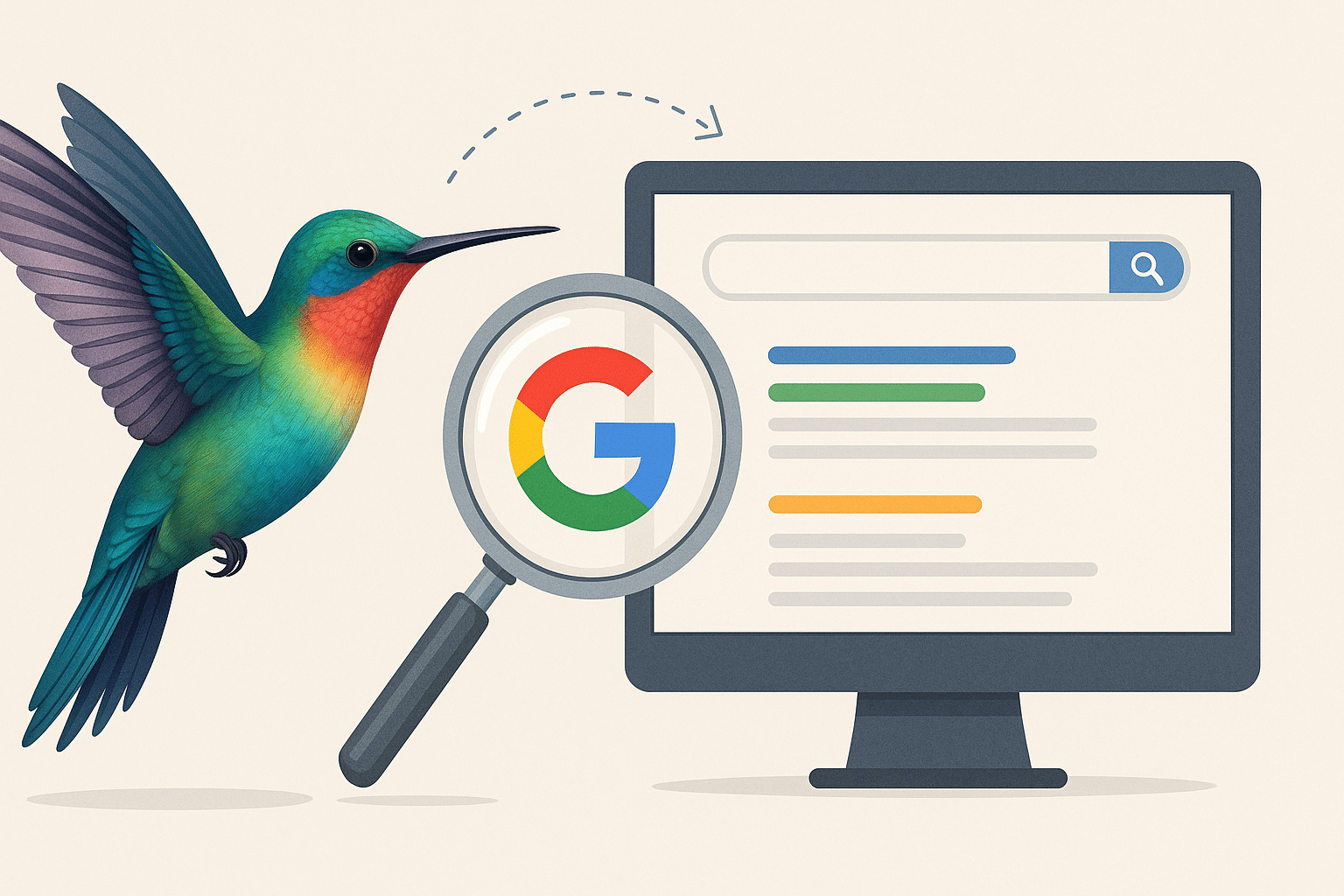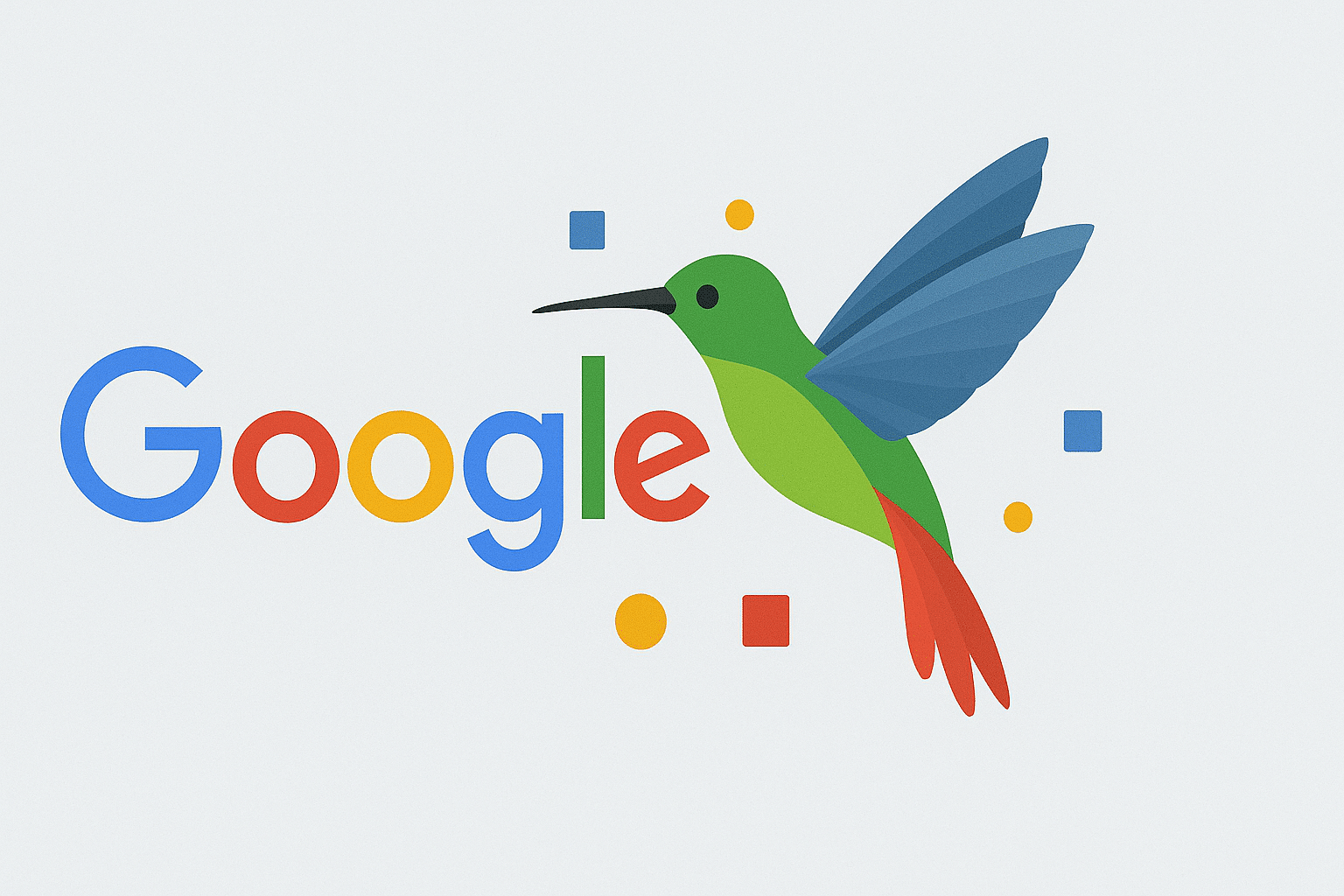What Is Google Hummingbird
Google Hummingbird is the name given to a major rewrite of Google’s search engine algorithm. Released in 2013, it was built to better understand what users mean when they search, not just match words to pages.
Instead of focusing only on keywords, Hummingbird looks at the whole query. It tries to figure out what the searcher wants, even if the exact words are not on the page. This shift made Google smarter at reading natural-language questions and giving results that feel more direct and helpful.
The update was designed to match the speed and precision of a real hummingbird. It helped Google move closer to semantic search, where the engine understands concepts, entities, and relationships between words.
How Google Hummingbird Impacted SEO
Google Hummingbird changed the way search engines ranked content. Before Hummingbird, many websites relied on repeating exact keywords to appear in search results. After the update, this method became less effective. Google began looking at the meaning behind the words, not just the words themselves.
This shift encouraged websites to write in natural language and focus on user intent. Content had to answer real questions, not just include search terms. Pages that used a clear structure, addressed specific topics, and included relevant entities started performing better.
Semantic search became central. Google connected ideas, recognized relationships between terms, and used this understanding to serve more accurate results. Websites that adapted to this change by improving context and clarity saw better rankings.
When Did Google Launch the Hummingbird Algorithm
Google Hummingbird was a big change in how Google understood searches. It started working in 2013 and helped Google read full questions better, not just match words. This made search faster, smarter, and more helpful for everyone.
Quiet Launch and Official Announcement
Google Hummingbird began working behind the scenes in late August 2013. The company officially revealed it on September 26, during its 15th anniversary celebration at the garage where Google was originally founded. At the time, Amit Singhal, Senior Vice President of Search, called it the most important change to Google’s algorithm since 2001.
The rollout was smooth. Most users never noticed the shift because search results continued to feel normal. Google later confirmed that Hummingbird had already been active for weeks before the public announcement. The quiet launch, without sudden drops or spikes in traffic, was seen as a sign of success.
Full Algorithm Rebuild
Unlike earlier updates such as Caffeine (2010), Panda, and Penguin (2011–2012), which improved specific parts of the system, Hummingbird was a full rebuild of the core algorithm. It kept proven tools like PageRank for link analysis, but redesigned how Google understood and processed searches.
The focus shifted to understanding natural-language queries and user intent, allowing Google to better interpret full questions instead of just matching keywords. This made search more conversational and context-aware.
Focus on Semantic Search
The name Hummingbird reflected the update’s goal: speed and precision in search results. Google confirmed that it affected 90 percent of all searches worldwide. The new algorithm supported the transition toward semantic search, where Google looks at meanings, relationships, and entities rather than only words on a page.
By combining old and new elements, Google created a system that could handle complex queries while keeping the stability and trust of earlier systems. Hummingbird marked the beginning of a deeper shift in how Google responds to search behavior.
How Google Hummingbird Changed the Search Algorithm

Google Hummingbird changed how search works. It helped Google understand what people really mean when they ask a question, not just look at each word. This made search results more helpful, natural, and easier to understand.
Shift from Keywords to Meaning
The main change in the Google Hummingbird algorithm was the move from keyword matching to semantic search. Instead of looking at words one by one, Hummingbird tries to understand the full meaning of the search. It focuses on the user intent behind the query, not just the words typed.
For example, if someone searches “what’s the best way to treat acid reflux”, Hummingbird understands the question and shows results about treatment options, not just pages with the words “acid” and “reflux”.
Use of the Knowledge Graph
A big part of Hummingbird’s power came from deeper use of the Google Knowledge Graph. This database connects over 570 million entities like people, places, and events. It helps Google understand links between ideas.
Take the query “What’s the capital of the country that hosted the 2016 Olympics?”. Hummingbird knows the 2016 Olympics were in Brazil, and the capital of Brazil is Brasília, so it shows that answer—even if those words are not in the question.
This concept-based search became a key part of how Google delivers fast and accurate answers.
Smarter Handling of Voice and Conversation
Around 2013, people started using voice search more. Spoken questions are longer and more natural, like “Where is the closest pizza place to my house?”. Older systems ignored words like “where” or “closest”. Hummingbird reads the full sentence and understands what the person really wants.
It also looks at location, context, and other signals to show nearby results, even if the question does not mention the city.
Summary of Key Changes
Hummingbird made Google smarter in three clear ways:
- Natural language processing: It reads full questions and understands meaning and tone, not just keywords.
- Knowledge Graph usage: It uses Google’s database of entities and relationships to connect ideas and show direct answers.
- Precise, context-aware results: It leads users to the exact section of a webpage that matches the query, not just the homepage.
How Google Hummingbird Affected Search Results and SEO
Google Hummingbird made search smarter by reading the full question, not just the words. This change helped users get better answers and pushed websites to focus on useful content instead of just repeating keywords.
Changes in Search Results
With Google Hummingbird, search results became more accurate, especially for long-tail queries. These are detailed searches like “acid reflux prescription” or “Pizza Hut calories per slice”. Before the update, Google matched words exactly. After Hummingbird, it understood what users meant.
For example, the phrase “acid reflux prescription” used to return a list of medicines. After Hummingbird, Google showed pages with treatment guidance, matching the user’s intent, not just the words. Similarly, asking “Pizza Hut calories per slice” now gives a direct answer from Pizza Hut’s website, instead of making users search manually.
Hummingbird allowed Google to interpret full queries, link meanings, and pull accurate facts, even when users didn’t phrase things perfectly.
Shift in SEO Strategy
Hummingbird changed how websites approach SEO. Google began rewarding pages that clearly explained a topic and answered real questions. Pages no longer needed to match exact keywords. Instead, Google looked at semantic depth, topic coverage, and natural phrasing.
This led to a new focus on:
- Writing in natural language, not keyword-heavy text
- Covering full topics, not just one phrase
- Organizing sites well with clear headings and internal links
- Using title tags and structured HTML to help Google understand content
Long-tail keywords became more useful, since Hummingbird could read full questions and connect them to pages with matching meaning, even without exact words.
From Keywords to Concepts
After Hummingbird, SEO moved from keyword-centric to topic-centric. Google encouraged content creators to focus on quality, clarity, and answering user questions. This aligned with earlier goals seen in Panda and later updates like RankBrain.
Hummingbird did not punish websites. It simply made it easier for Google to show the most helpful content. Pages with thin or shallow writing often lose visibility. Meanwhile, sites with solid, well-organized answers began ranking better—even if they had not optimized for specific search terms.
What Came After Google Hummingbird
Google Hummingbird started a new chapter in search. It helped Google go beyond just matching words and learn how to truly understand questions. Later updates like RankBrain and BERT followed the same path and made search even smarter.
Rise of AI in Google Search
After Hummingbird launched in 2013, Google began building smarter tools to understand language better. One of the first was RankBrain, introduced in 2015. It used machine learning to help Google guess the meaning of new or unclear search queries. For example, if someone typed something Google had never seen before, RankBrain could still find related results by using word vectors—math-based patterns that connect related ideas.
RankBrain was not a replacement for Hummingbird. It became part of the overall system and handled around 15 percent of daily searches, especially those with unusual wording. This marked a clear move away from exact keyword matching and toward intent-based search.
By working within the Hummingbird framework, RankBrain became one of Google’s most important ranking signals, showing how AI was now a key part of the search process.
Introduction of BERT and Deeper Language Understanding
In 2019, Google introduced BERT (Bidirectional Encoder Representations from Transformers), a deep learning algorithm that understands the full context of a sentence. While Hummingbird and RankBrain focused on what the user was asking, BERT helped Google understand how the question was asked.
BERT pays close attention to small words like “to” or “from” that can change a sentence’s meaning. For example, “train to Chicago” and “train from Chicago” are very different. BERT helps Google pick the right result based on sentence structure and word order.
Like RankBrain, BERT works within the system that started with Hummingbird. It continues the goal of understanding real conversation and natural language better than ever before.
Long-Term Impact on Search and SEO
The legacy of Hummingbird is still seen today. It paved the way for semantic search, featured snippets, and better voice search results. Later tools like MUM (Multitask Unified Model), introduced in 2021, expanded search even more. MUM can handle both text and images and answer complex questions with more depth.
All these tools reflect the core idea behind Hummingbird: search should understand meaning, not just match words. Content creators also had to change their approach. Instead of stuffing pages with keywords, they began writing clearly and naturally to match how people really ask questions.
Google now ranks pages higher when they answer questions well and provide value to the reader. This focus on user intent remains central to Google’s algorithm, and it started with the design of Hummingbird.
Hummingbird’s Place in Google’s History
Launched in 2013, Google Hummingbird marked the official shift from keyword search to language understanding. It rebuilt the core of Google’s algorithm to be faster, more precise, and more helpful for modern queries. The system it introduced became the base for all future updates involving AI, contextual awareness, and natural-language processing.
References
- https://www.eyerys.com/articles/news/google-and-hummingbird-algorithm
- https://www.searchenginejournal.com/google-algorithm-history/hummingbird-update/
- https://www.theguardian.com/technology/2013/sep/27/google-biggest-algorithm-change-hummingbird
- https://robhof.com/2013/09/26/meet-hummingbird-google-just-revamped-search-to-answer-your-long-questions-better/
- https://en.wikipedia.org/wiki/Google_Hummingbird
- https://techxplore.com/news/2015-10-google-scientist-rankbrain.html
- https://www.equinetmedia.com/blog/panda-penguin-hummingbird…-a-beginners-guide-to-google-algorithms
- https://yoast.com/google-algorithm-updates/


